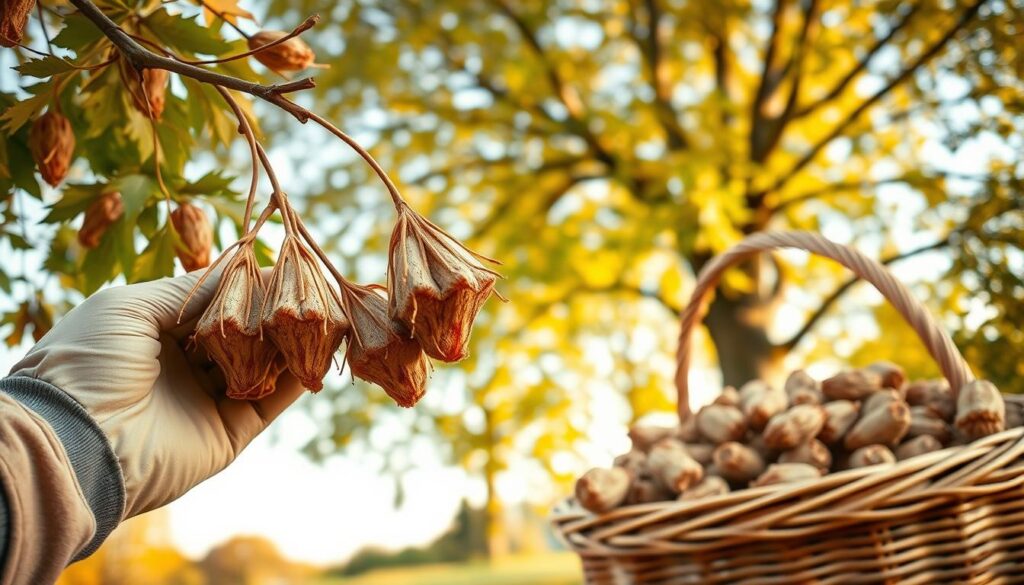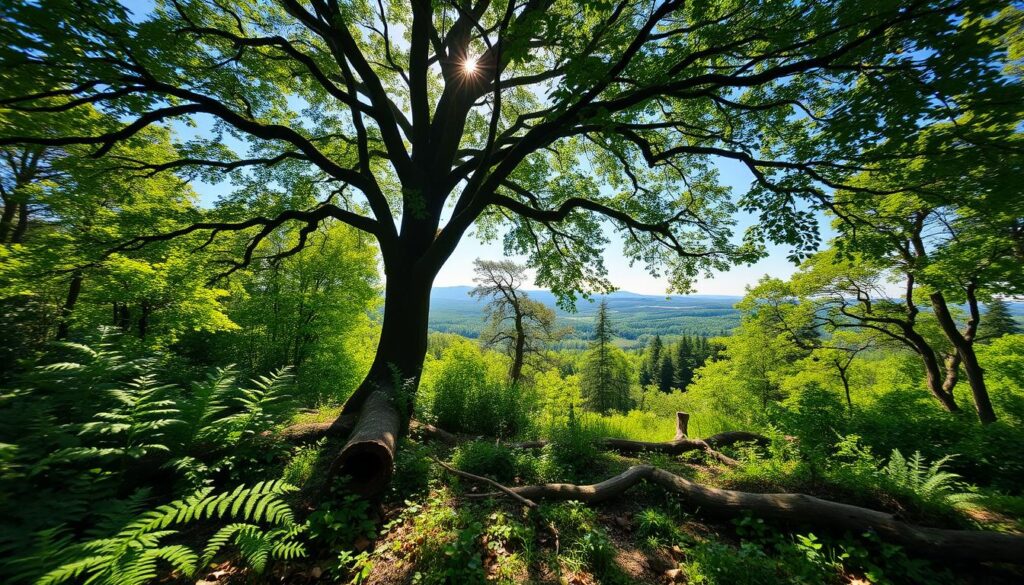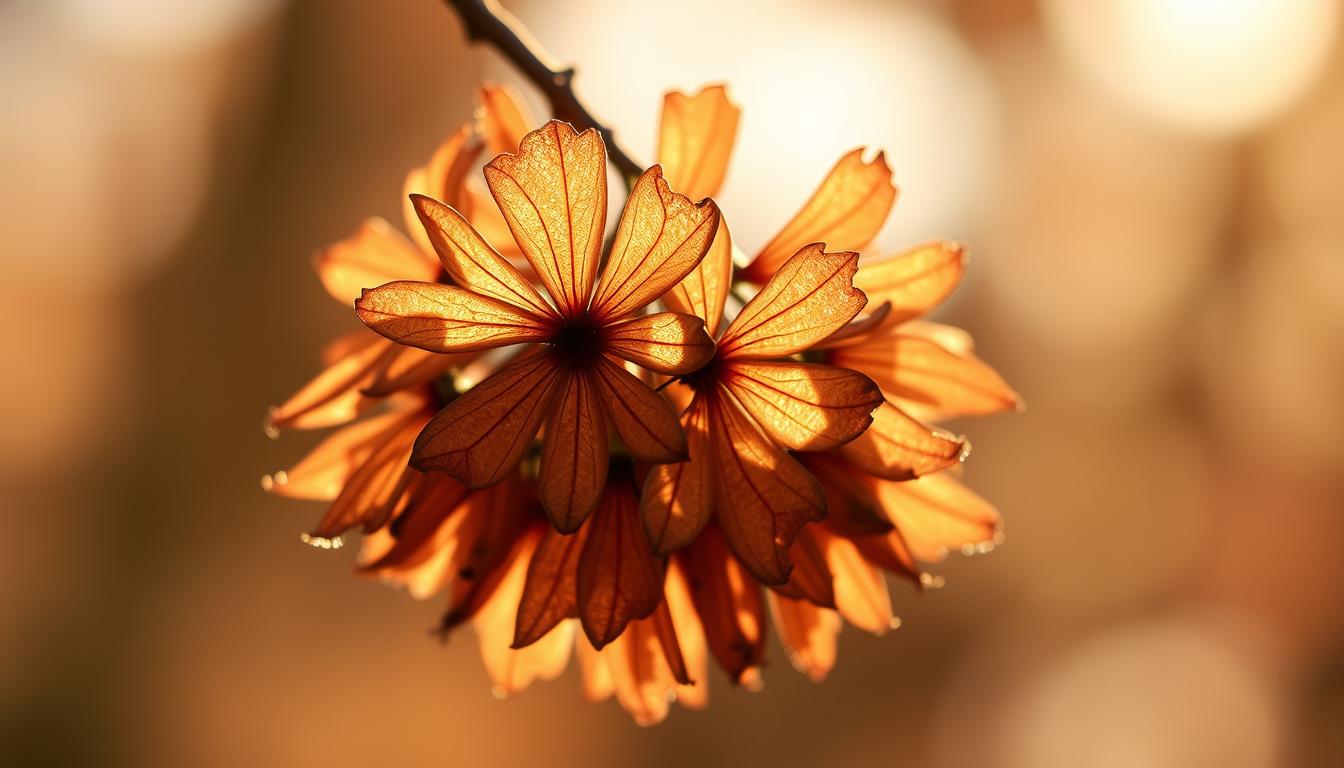Have you ever stopped to think about the tiny seeds floating in the air? They carry the future of entire forests. Ash tree seeds, part of the Fraxinus species, tell incredible stories. They show us resilience, adaptation, and the magical journey of life.
These seeds are part of a fascinating world that thrives quietly. They have special ways to spread through the wind. And they play a big role in making forests grow again.
Let’s dive into five surprising facts about ash tree seeds. They will change how you see these tiny wonders. Whether you love nature, are curious about plants, or just enjoy learning about our world, get ready to be amazed.
Table of Contents
Understanding the Beauty of Ash Trees
Ash trees are magnificent native plants that capture the hearts of nature lovers and botanists. They show a perfect mix of strength and beauty in the plant world. Their unique traits make them a subject of study and admiration.
Exploring ash trees reveals a wide range of diversity across different ecosystems and areas. These trees are more than just plants. They are complex beings with detailed growth patterns and the ability to adapt.
Physical Characteristics That Amaze
Ash trees have distinct physical traits that make them stand out. Their features include:
- Compound leaves with multiple leaflets
- Smooth or slightly furrowed bark
- Branches that grow in an opposite pattern
- Impressive height ranging from 10 to 40 meters
Species Diversity Across Landscapes
The Fraxinus genus has a wide range of species suited to different environments. From mountains to cities, these native plants show great resilience.
| Ash Tree Species | Native Region | Average Height |
|---|---|---|
| White Ash | Eastern North America | 18-30 meters |
| Green Ash | Central United States | 12-24 meters |
| Blue Ash | Midwestern United States | 15-25 meters |
Seasonal Transformations
Ash trees change beautifully throughout the year. Their ability to adapt to changing conditions is truly remarkable. In autumn, their leaves turn vibrant yellow and purple, creating a stunning sight.
The Life Cycle of Ash Tree Seeds
The life cycle of ash tree seeds is truly fascinating. It starts with the delicate spring flowers on ash trees. These flowers are small and often missed by people walking by.
The seeds develop specifically to help the tree survive and grow. Each seed features a unique winged structure known as a samara, which allows the seeds to travel far from the tree.
- Flowering occurs in early spring
- Seeds develop from pollinated flowers
- Samaras mature throughout summer
- Seed dispersal happens in late summer to autumn
Each samara has a single seed and a wing. This wing catches the wind, helping the seed travel. This way, the seeds can grow in many different places.
| Seed Development Stage | Typical Duration | Key Characteristics |
|---|---|---|
| Flower Formation | Early Spring | Small, inconspicuous clusters |
| Seed Development | Spring to Summer | Winged samaras form |
| Seed Dispersal | Late Summer/Autumn | Wind-assisted distribution |
Even though different ash trees might have slightly different cycles, the basic idea of using the wind to spread seeds stays the same. Learning about these details shows us how nature works to keep species alive.
Cultural and Historical Significance
Ash trees have a deep connection with human culture. They are more than just plants in forestry and horticulture. Their importance spans centuries, touching many parts of human life through their uses and meanings.
Traditional Medicinal Applications
Indigenous cultures around the world have valued ash trees for their healing properties. Native American tribes used ash tree parts like seeds and bark for medicine. These remedies helped with fever, pain, and breathing problems.
- Treating fever and inflammation
- Creating pain relief preparations
- Developing herbal tonics for respiratory issues
Historical Craftsmanship Importance
Ash wood is known for its strength and flexibility in woodworking. Skilled craftsmen have made many useful and beautiful items from ash, such as:
- Agricultural tools and handles
- Elegant furniture pieces
- Sporting equipment like baseball bats
- Intricate woodcarving designs
Cultural Symbolism Across Civilizations
Ash trees hold deep symbolic meanings in many cultures. Norse mythology saw the ash as the World Tree, linking the cosmos and wisdom. Ash trees are seen as symbols of strength, resilience, and change.
The ash tree stands not just as a botanical entity, but as a living testament to human cultural diversity and connection with nature.
Ash Tree Seeds: Collection and Storage

Collecting ash tree seeds needs careful planning and skill. Your seed collection strategy is key to keeping these valuable genetic resources safe. The best time to gather seeds is late summer to early autumn. This is when the seeds are mature but still on the tree.
Understanding the right harvesting techniques is part of sustainable sourcing. Look for mature ash trees with healthy seed clusters. Make sure you don’t harm the parent tree when collecting. Here are some effective seed gathering methods:
- Gently shake branches to collect fallen seeds
- Use clean collection bags or sheets under the tree
- Select seeds that appear plump and undamaged
- Avoid collecting seeds from stressed or diseased trees
Proper storage is key to keeping seeds alive. After collecting, clean the seeds well and remove any debris. Seed viability depends on precise environmental conditions. Store ash tree seeds in a cool, dry place with controlled temperature and humidity.
Your storage strategy should include:
- Using sealed, breathable containers
- Maintaining temperatures between 32-41°F (0-5°C)
- Keeping moisture levels low to prevent mold
- Checking seeds periodically for quality
Both professional foresters and hobbyist gardeners can benefit from these sustainable sourcing techniques. By following careful collection and storage methods, you’ll help preserve the genetic diversity of ash trees for future generations.
Natural Propagation Methods
Ash trees have amazing ways to spread their seeds. This shows how nature is full of clever designs. Their survival depends on how they disperse and germinate seeds. This lets them grow in many different places.
Learning about how ash trees spread shows a cool biological process. It helps their species grow in different landscapes.
Wind Dispersal Mechanisms
Ash tree seeds have a special winged structure called a samara. This lets them fly through the air. They can go far from their parent tree, helping them grow in new places.
- Samaras spin like helicopter blades during flight
- Seeds can disperse as far as 330 feet from the parent tree.
- Wind currents help distribute seeds across diverse terrains
Germination Requirements
For ash tree seeds to grow, they need the right conditions. They need the right temperature, moisture, and soil. This helps them turn into strong seedlings.
- Optimal soil temperature: 68-86°F
- Moisture level: Consistent but not waterlogged
- Soil pH: Slightly acidic to neutral (6.0-7.5)
Seedling Development Stages
The journey from seed to sapling is full of challenges. Young ash trees need the right nutrients and conditions to grow. Each stage is crucial for their success.
“Nature’s most complex design is often found in its simplest processes” – Unknown Botanist
Understanding how ash trees spread shows their amazing ability to adapt. This lets them thrive and reproduce in many different places.
Environmental Impact and Ecosystem Services

Ash trees are key to keeping ecosystems healthy in forests. They help keep the environment balanced and support many animals. Their roots and leaves are important for the planet’s health.
Ash trees do more than just look good. They play many important roles:
- They help control the climate by absorbing carbon.
- They keep the soil in place and prevent erosion.
- They provide homes for wildlife.
- They help keep biodiversity strong.
Many animals rely on ash trees to survive. Birds, insects, and small mammals use them for shelter and food. The seeds of ash trees are a big hit with birds, especially during tough times.
Forestry experts see ash trees as essential in many areas. They help keep ecosystems connected, supporting both plants and animals. It’s vital to protect these trees for the health of our planet.
“Ash trees are not just trees, but living infrastructure supporting entire ecological systems.” – Forest Ecology Research Institute
Learning about ash trees’ role in ecosystems shows their value in caring for our planet. By valuing their contributions, we can work to preserve these natural wonders.
Threats and Conservation Efforts
Ash trees face big challenges today, like invasive species and environmental changes. It’s key to understand these threats for their survival and sustainable use.
Emerald Ash Borer Devastation
The Emerald Ash Borer (EAB) is a major threat to ash trees in North America. This tiny beetle, from Asia, has caused huge damage since it arrived in the early 2000s.
- Native to eastern Asia
- First detected in Michigan in 2002
- Kills ash trees within 2-4 years of infestation
- Responsible for killing millions of ash trees nationwide
Protection Strategies
Experts have come up with ways to fight the EAB. They focus on stopping it before it starts, finding it early, and managing ash trees well.
- Biological control through parasitic wasps
- Chemical treatments for individual trees
- Quarantine of infected areas
- Genetic research for resistant ash varieties
Recovery Programs
It’s vital to save ash tree populations. By using them wisely and managing them well, we can help them come back.
Scientists and forestry experts are working together. They’re using seed banking, genetic preservation, and restoring ecosystems to help ash trees.
Protecting ash trees is not just about preserving a species, but maintaining the delicate balance of our forest ecosystems.
Growing Ash Trees from Seeds
Growing ash trees from seeds needs patience and the right horticulture techniques. You must know how to make the seeds germinate well. This means understanding their unique needs and creating the best growing conditions.
Before you start growing ash tree seeds, you need to prepare well. This process has several important steps. These steps can greatly affect your success in growing these beautiful trees.
- Collect mature ash tree seeds in late autumn
- Perform cold stratification to simulate natural winter conditions
- Select a well-draining soil mixture
- Maintain consistent moisture during germination
Germinating ash tree seeds is simple but requires careful attention. First, store the seeds in a cool, moist place for 60-90 days. Cold stratification replicates the natural winter conditions these seeds experience in the wild.
When you plant the seeds, pick a spot with some sunlight and protection from strong winds. The soil should be rich in organic matter and drain well. Seeds usually start growing in 2-3 weeks after stratification.
Pro tip: Patience is key in ash tree seed propagation. Not every seed will develop into a healthy, thriving tree.
Keep a close eye on the seedlings as they grow. Protect them from extreme temperatures and make sure they get enough water. Slowly introducing them to more sunlight and less water as they get bigger.
- Monitor soil moisture regularly
- Protect seedlings from direct afternoon sun
- Transplant when seedlings reach 4-6 inches tall
- Use organic fertilizers sparingly
By learning these germination techniques and giving careful attention, you can grow ash trees from seeds. This helps restore local ecosystems.
Sustainable Harvesting Practices
Sustainably collecting ash tree seeds is key. Your actions can greatly affect forests and tree numbers. Knowing how to collect seeds responsibly helps protect trees and forests.
Here are important steps for collecting ash tree seeds:
- Identify mature seeds with proper coloration and hardness
- Select seeds from healthy, diverse parent trees
- Limit collection to no more than 20% of available seeds
- Use non-invasive collection techniques
Choosing seeds wisely is part of sustainable forestry. Focus on genetic diversity and avoid harming parent trees. Look for seeds that are fully developed, brown or dark, and easily fall off the tree.
| Seed Collection Method | Impact Level | Recommended Frequency |
|---|---|---|
| Hand Picking | Low | Every 2-3 years |
| Ground Collection | Very Low | Annually |
| Mechanical Harvesting | High | Rarely |
Your role goes beyond just collecting seeds. Documenting where seeds come from, tracking their genetic history, and supporting local conservation is crucial. This helps ensure ash trees thrive for generations to come.
Practical Applications and Uses
Ash tree seeds are very useful in horticulture and for fixing the environment. They are not just for growing trees. They are also important for many industries and green projects.
In projects to restore native plants, ash tree seeds are key. Landscape experts and scientists use them to fix damaged ecosystems. This is especially true in places where trees have been cut down or harmed.
- Urban landscaping design
- Habitat reconstruction efforts
- Sustainable agriculture practices
- Scientific research applications
Ash tree seeds also offer significant benefits to agroforestry systems. These trees grow fast and can adapt well. Farmers like them because they help the soil and block strong winds.
| Application | Key Benefits |
|---|---|
| Ecological Restoration | Rapid ecosystem regeneration |
| Urban Forestry | Enhanced green infrastructure |
| Agricultural Systems | Soil improvement and biodiversity |
Researchers are looking into ash tree seeds for medicine. Early studies show they might have uses in both old and new medicines. This shows how versatile these seeds are.
Ash tree seeds represent a powerful intersection of ecological sustainability and practical innovation.
By using ash tree seeds, you help make the environment better. This is true in many fields.
Conclusion
Ash tree seeds are key to forest health and saving native plants. Knowing about these seeds helps protect ash trees in the U.S. Tree growing methods are now crucial because of environmental threats.
The story of ash tree seeds shows nature’s strength and complexity. They play a big part in forest growth. Learning about them helps us see how forests and plants are connected.
We all need to work together to save ash trees. You can help by supporting local conservation, joining plant restoration efforts, and sharing what you know. Every action helps keep ash trees alive for the future.
As caretakers of our planet, we see how ash tree seeds affect nature. By protecting these plants, we help keep our forests diverse and healthy. Your efforts can make a big difference in saving our forest’s plant life.
FAQ
What are ash tree seeds, and how are they different from other tree seeds?
Ash tree seeds, or samaras, are unique. They have a long wing that helps them fly away. This lets them spread seeds far and wide.
How long does it take for an ash tree seed to germinate?
Ash tree seeds need cold to grow. They need 60-90 days of cold and about 2-3 months to sprout. The time it takes depends on the seed and the environment.
Can I collect ash tree seeds for personal propagation?
Yes, you can collect ash tree seeds. But do it in a way that doesn’t harm the trees. Pick mature seeds in late summer or early fall. Store them right and don’t take too many.
What are the main threats to ash tree seed production?
The main threat is the Emerald Ash Borer. It harms ash trees and makes it hard for them to produce seeds. Climate change and losing habitats also hurt seed production.
How do ash tree seeds contribute to ecosystem health?
Ash tree seeds are vital for wildlife and forests. They help trees grow back and keep the soil stable. They also help fight climate change.
What are the best conditions for growing ash trees from seeds?
To grow ash trees from seeds, you need good soil and the right temperature. Keep the soil moist and the temperature between 60-70°F. Plant them in a spot with some sun but not too much.
How many species of ash trees exist?
There are about 65 types of ash trees. They are widely distributed across various regions around the world. Each type is special and fits its environment.
Are ash tree seeds used for anything other than tree propagation?
Ash tree seeds are used in many ways. They help restore habitats, are used in science, and for landscaping. Some cultures use them for medicine.
What steps can I take to safeguard ash trees from the Emerald Ash Borer?
To protect ash trees, watch for signs of the Emerald Ash Borer. Use natural enemies, quarantine, and insecticides if needed. Talk to local experts for the best advice.
What is the typical lifespan of an ash tree?
Ash trees can live a long time, up to 300 years. How long they live depends on the soil, climate, and if they are protected from pests and diseases.

